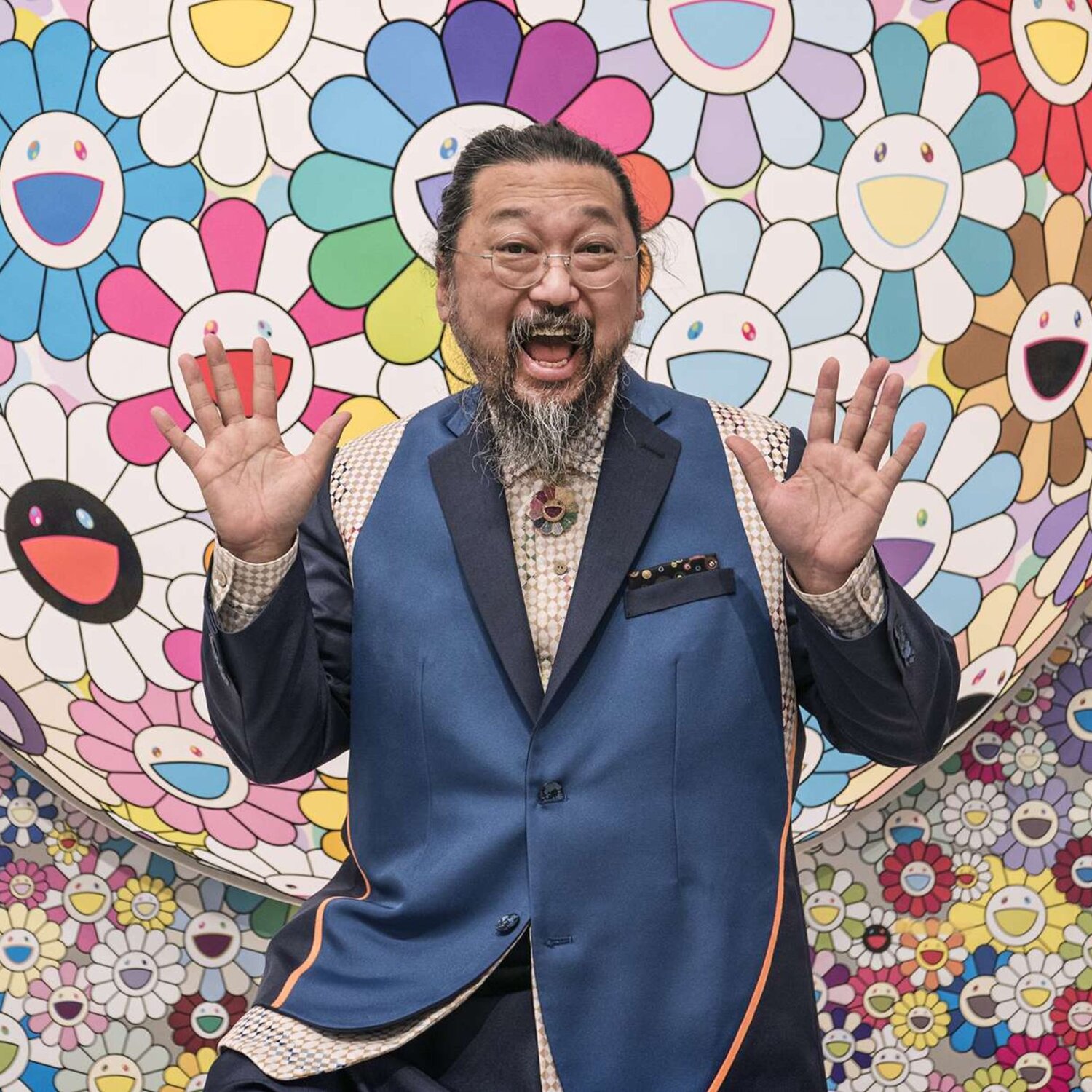TAKASHI MURAKAMI
Photo: Fondation Louis Vuitton / Martin Raphaël Martiq
Japanese artist Takashi Murakami is a global artistic force. Even if you’re not an art world enthusiast, you recognize his designs from the album covers for Kanye West’s Graduation and Kid Cudi’s Kids See Ghosts and the music video for Billie Eilish’s you should see me in a crown. He’s also done collaborations with Marc Jacobs, Louis Vuitton, Virgil Abloh, Google, Vans, and Supreme. Murakami is not just a commercial presence though, but also a darling in the art world , known for his painting, sculpting, and iconic smiling flowers. His fine artwork has sold in a Sotheby’s auction for $15 million and he also holds a PhD in Nihonga, a traditional Japanese style of painting. At only 57, Murakami has been massively successful for decades, enjoying international prominence since the 1990s. With all of his ubiquity and obvious talent, it’s surprising that Takashi Murakami’s career is in part the product of a devastating childhood accident.
Takashi Murakami was born in Tokyo in 1962, making him, and his brother Yuji, who is also a painter, part of the defining artists that would emerge in post-WWII Japan. With a father who was a taxi-driver and a mother who was a homemaker, the family did not have much money and lived in a one-room apartment, but still took Takashi and his brother to the art museum weekly, asking them to write critiques of the art afterward. As a middle schooler, Takashi fell into a hole in the ground, breaking his skull and some bones in his right hand. His injuries prevented him from going to school for a month and he fell behind academically. Murakami’s struggle in middle school led to him attending a less than stellar high school where he became more and more socially isolated. When he went to meet with a teacher about university applications senior year, his teacher told him that he couldn’t get into university, “no matter how low he set his sights.”
photo: TAKASHI MURAKAMI/INSTAGRAM
As a kid, with the exception of Goya’s Saturn painting, Takashi had thought that the paintings his family went to look at on their weekly trips to the museum were boring. On the other hand, Goya’s painting prompted Murakami to think to himself that “if work doesn’t move people and induce a ‘wow’ then it’s all for nothing.” As he got older, he began to consider himself an otaku; he loved to watch a great deal of tv and spent a lot of time reading manga and watching anime in high school.
After the meeting with his teacher, Murakami figured he would try applying to an arts university where his lack of academic achievement wouldn’t count so heavily against him and that he would try to become an animator. Murakami failed the art school entrance exams and spent two years going to a prep school in order to try and reapply. During this time, he became a big fan of Hayao Miyazaki and of fan-drawn manga inspired by Star Wars.
Murakami did eventually gain a place at Tokyo University of the Arts, but had to accept a spot studying Nihonga, a type of traditional painting that initially bored him out of his mind. He found himself drawn to contemporary work by artists like Shinro Ohtake, Ansel Kiefer, and Sigmar Polke. After completing a bachelor’s degree in 1986 and then a PhD in 1993, Murakami went to New York to further pursue his interest in contemporary art and eventually launch his career. The ancient style of Nihonga became the basis from which Takashi Murakami pursued contemporary art, ultimately coining the term “Superflat” to describe both the visual thread he recognized running through the high culture traditional style and “low culture” manga and anime of Japan and to describe his artistic philosophy (i.e. embracing the interfusion of fine art and entertainment).
photo: Nathan Keay
Takashi Murakami launched Hiropon Factory in 1996 and in 2001, Murakami incorporated his production workshop and artist management company as Kaikai Kiki Co Ltd., featuring a roster of painters, designers, filmmakers and DJs that stage exhibitions and produce merchandise, with offices in major cities around the world. Murakami’s work has been exhibited in New York, Tokyo, Los Angeles, Hong Kong, Ibiza, and Paris and he continues to produce more, currently working on a sequel to his live-action film Jellyfish Eyes. Takashi’s influence and achievement has been recognized multiple times, with dozens upon dozens of awards and featured exhibitions. Notably he was the only artist to be named to Time’s Most Influential People in 2008. Murakami’s success can probably be attributed to his artistic talent and his forward thinking, which blends intellectual insight with business acumen. His unique approach can also be seen in his personal life. Murakami and his wife, who have a son and a daughter, reside in different cities and communicate primarily via FaceTime, with him extolling the fulfillment he finds as an otaku. While both his artistic process and life philosophies may draw criticism, he finds it a kind of validation of the interests he developed as a teenager. “I love the fantasy world. It’s much more real because we can record it. It’s much better than real life.”



